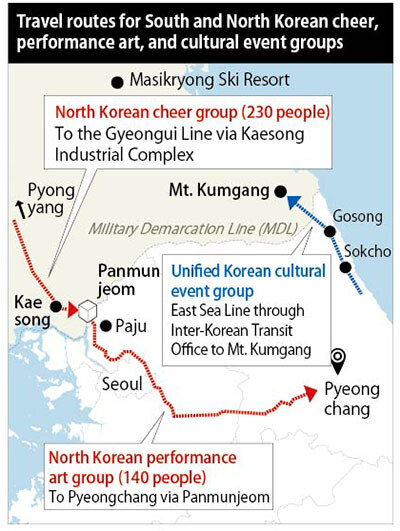hankyoreh
Links to other country sites 다른 나라 사이트 링크
Overland routes linking South and North Korea to reopen during Pyeongchang Olympics

All three of the blocked overland routes between South and North Korea are expected to open during the Pyeongchang Winter Olympics. During the vice-minister inter-Korean talks held at the House of Peace on the South Korean side of Panmunjeom on Jan. 17, the two sides reached an agreement about the size of the North Korean delegation to the Pyeongchang Winter Olympics and the route that it will take.
The plan is for North Korea’s athletes, cheer group of more than 230 members and Taekwondo demonstration team (more than 30) to travel to and from the Olympics on the Gyeongui Line overland route near the West Sea. The joint cultural event at Mt. Kumgang and the joint training for South and North Korean skiers at the Masikryong Ski Resort (in Wonsan, Gangwon Province) that the two sides also agreed to hold during the meeting will require the opening of the East Sea Line as well.
During previous working-level talks on Jan. 15, South and North Korea agreed for a North Korean 140-person musical performance group to pass through Panmunjeom. In other words, all three of the closed overland routes between South and North Korea will be reopened to allow the North to participate in the Pyeongchang Olympics.
The overland route on the West Sea Line refers to the Gyeongui Line, which is the transportation route used by tenant companies at the Kaesong Industrial Complex. Provisional use of this route began in early 2003 by vehicles that were preparing to develop the Kaesong Complex, and in Jan. 2006, the route was fully activated along with the East Sea Route following the opening of the inter-Korean transit offices.
The Gyeongui Line has been closed to traffic since the Kaesong Complex was completely shut down in Feb. 2016. In 2015, before the complex was closed, a total of 129,804 individuals and 99,518 vehicles used the Gyeongui Line to pass between South and North Korea. At the time of the second inter-Korean summit in Oct. 2007, South Korean President Roh Moo-hyun used this road to cross into North Korea before walking back into South Korea across the military demarcation line.
North Korea to host cultural event, joint training for Korean skiers
South and North Korea have agreed to hold a joint cultural event at Mt. Kumgang prior to the opening ceremony of the Pyeongchang Olympics and for skiers from both sides to train together at the Masikryong Ski Resort, both of which are in the North, which will require the use of the overland route on the East Sea Line. This road came into use in Feb. 2003 when overland tourism to Mt. Kumgang began on a trial basis.
At the peak of tourism to Mt. Kumgang in 2007, over 2 million people crossed the border on the East Sea Line overland route. But this route has been blocked since the termination of tours to Mt. Kumgang following the shooting of a tourist there in July 2008, just one year later, with the road only opening temporarily for religious events and divided family reunions.
The fact that South and North Korea came to an understanding about opening not only the Gyeongui Line on the West Sea but also the overland route on the East Sea symbolizes that the Pyeongchang Olympics are starting to break through the impasse in inter-Korean relations.
Since the inter-Korean overland routes cross the military demarcation line, their use must be approved by the UN Command, which has jurisdiction of the military demarcation line. But this approval is a mere formality, and the UN Command has typically cooperated with inter-Korean agreements.
“It’s very significant that all three of the inter-Korean overland routes are being reopened. When people start traveling along roads that once were closed, we’ll also move down the path toward restoring inter-Korean relations,” said Kim Yeon-cheol, a professor at Inje University.
By Noh Ji-won, staff reporter
Please direct questions or comments to [english@hani.co.kr]

Editorial・opinion
![[Column] Park Geun-hye déjà vu in Yoon Suk-yeol [Column] Park Geun-hye déjà vu in Yoon Suk-yeol](https://flexible.img.hani.co.kr/flexible/normal/500/300/imgdb/original/2024/0424/651713945113788.jpg) [Column] Park Geun-hye déjà vu in Yoon Suk-yeol
[Column] Park Geun-hye déjà vu in Yoon Suk-yeol![[Editorial] New weight of N. Korea’s nuclear threats makes dialogue all the more urgent [Editorial] New weight of N. Korea’s nuclear threats makes dialogue all the more urgent](https://flexible.img.hani.co.kr/flexible/normal/500/300/imgdb/original/2024/0424/7317139454662664.jpg) [Editorial] New weight of N. Korea’s nuclear threats makes dialogue all the more urgent
[Editorial] New weight of N. Korea’s nuclear threats makes dialogue all the more urgent- [Guest essay] The real reason Korea’s new right wants to dub Rhee a founding father
- [Column] ‘Choson’: Is it time we start referring to N. Korea in its own terms?
- [Editorial] Japan’s rewriting of history with Korea has gone too far
- [Column] The president’s questionable capacity for dialogue
- [Column] Are chaebol firms just pizza pies for families to divvy up as they please?
- [Column] Has Korea, too, crossed the Rubicon on China?
- [Correspondent’s column] In Japan’s alliance with US, echoes of its past alliances with UK
- [Editorial] Does Yoon think the Korean public is wrong?
Most viewed articles
- 1‘We must say no’: Seoul defense chief on Korean, USFK involvement in hypothetical Taiwan crisis
- 2N. Korean delegation’s trip to Iran shows how Pyongyang is leveraging ties with Moscow
- 3‘Weddingflation’ breaks the bank for Korean couples-to-be
- 4Korea sees more deaths than births for 52nd consecutive month in February
- 546% of cases of violence against women in Korea perpetrated by intimate partner, study finds
- 6Will NewJeans end up collateral damage in internal feud at K-pop juggernaut Hybe?
- 7[Column] Park Geun-hye déjà vu in Yoon Suk-yeol
- 8[Editorial] New weight of N. Korea’s nuclear threats makes dialogue all the more urgent
- 9Amnesty notes ‘erosion’ of freedom of expression in Korea in annual human rights report
- 10“Parental care contracts” increasingly common in South Korea